Goldenrods are late-season wildflowers bearing big sprays of beautiful golden blooms that are both a delight to behold and an important food source for birds and pollinators.
And with over 120 different species, there’s one well-suited to nearly every growing situation – wet or dry conditions, full sun or shade, vast meadows or compact gardens.
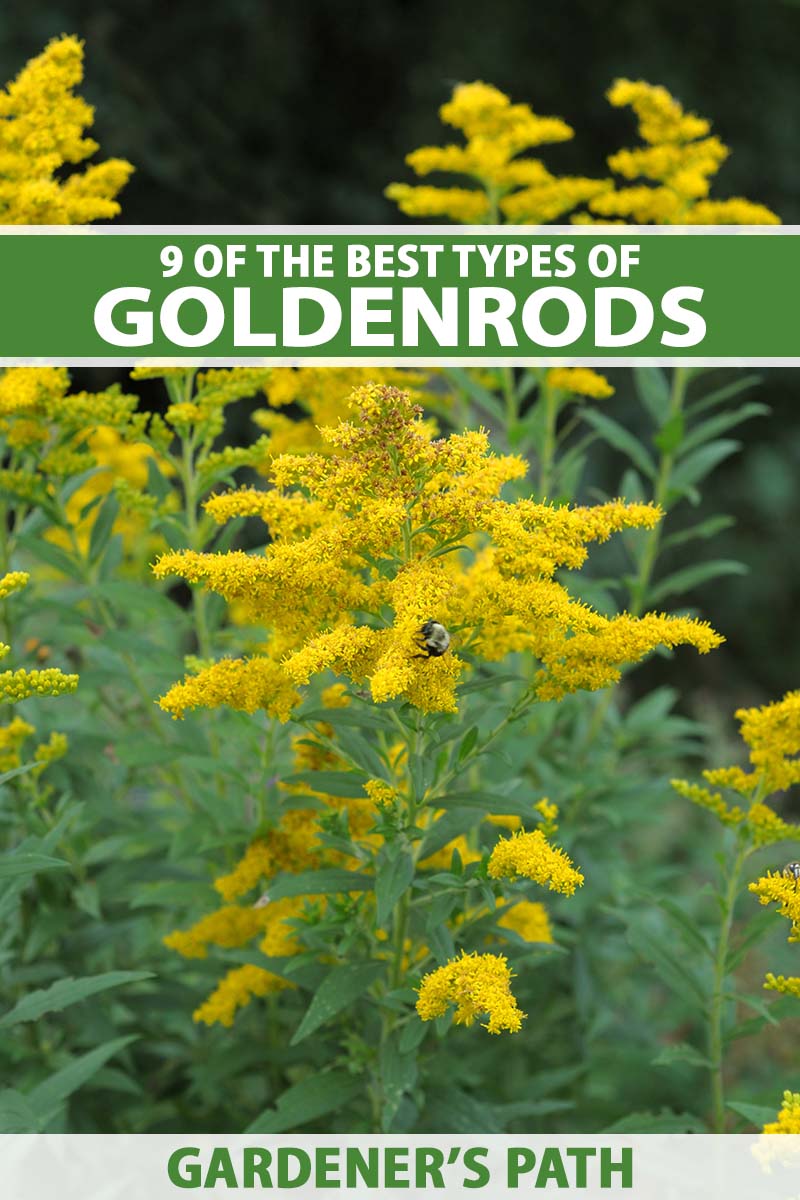
We link to vendors to help you find relevant products. If you buy from one of our links, we may earn a commission.
In this article we’re going to get to know nine different species of goldenrods, examining their sun, soil, and water needs, as well as their growth habit, flowers, foliage, bloom time, and hardiness zones.
Outfitted with these details, you should be able to choose the one (or maybe even two!) that will work perfectly in your landscape.
Here’s a peek at our list:
9 of the Best Types of Goldenrods to Grow
Before we get started, if you need some tips on growing this wildflower, be sure to consult our guide to growing goldenrods in the landscape, where you’ll discover a selection of recommended Solidago cultivars as well.
1. Blue-Stemmed
Blue-stemmed goldenrod is native to eastern North America, with a range that extends from Quebec to Texas.
Classified scientifically as S. caesia, this species is also known as “blue stem goldenrod,” and “wreath goldenrod.”
In the wild, S. caesia is found growing in clearings, meadows, woodlands, and wood edges, and is sometimes also referred to as “woodland goldenrod.”
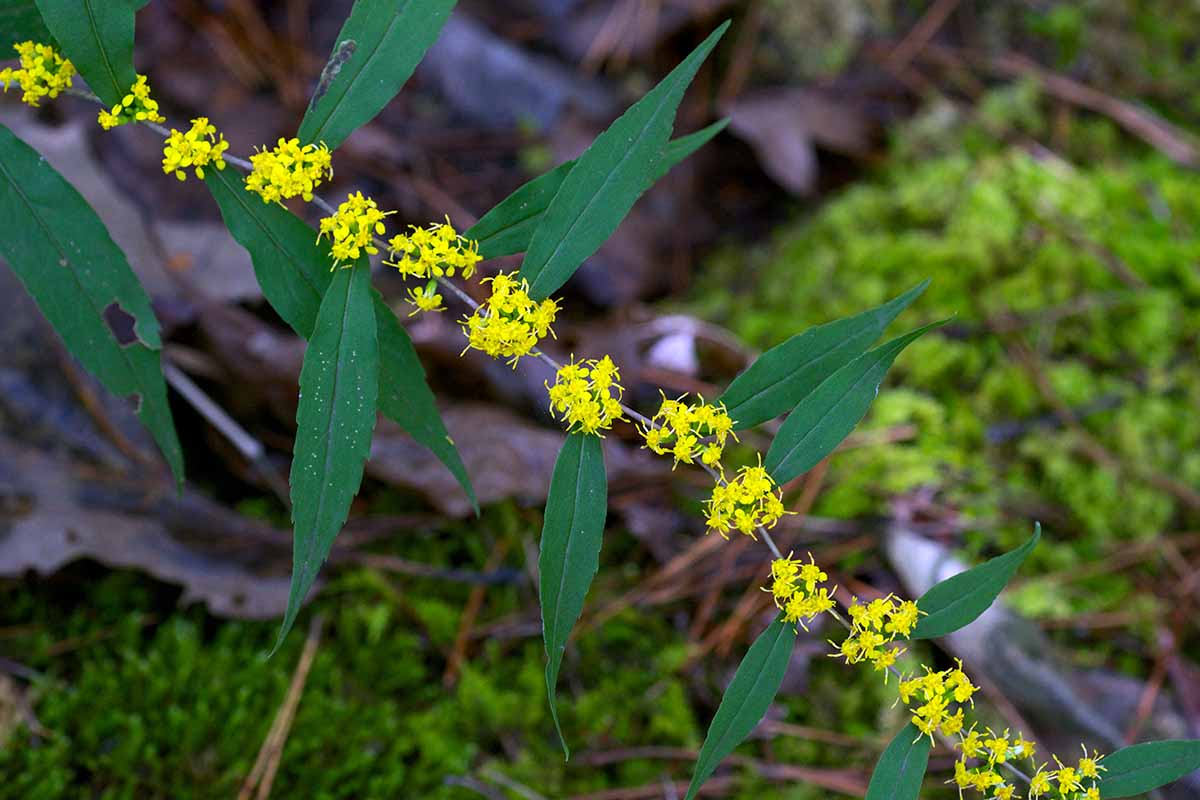
This wildflower has delicately arching inflorescences covered with sulfur-yellow flowers, and it blooms from late summer through fall.
The flowers of this plant grow in its leaf axils, providing this species with yet another common name, “axillary goldenrod.”
Leaves are green, lance-shaped, and smooth, with serrated leaf margins. Stems on mature plants have a blue or purple hue, inspiring this species’ most frequently used common name.
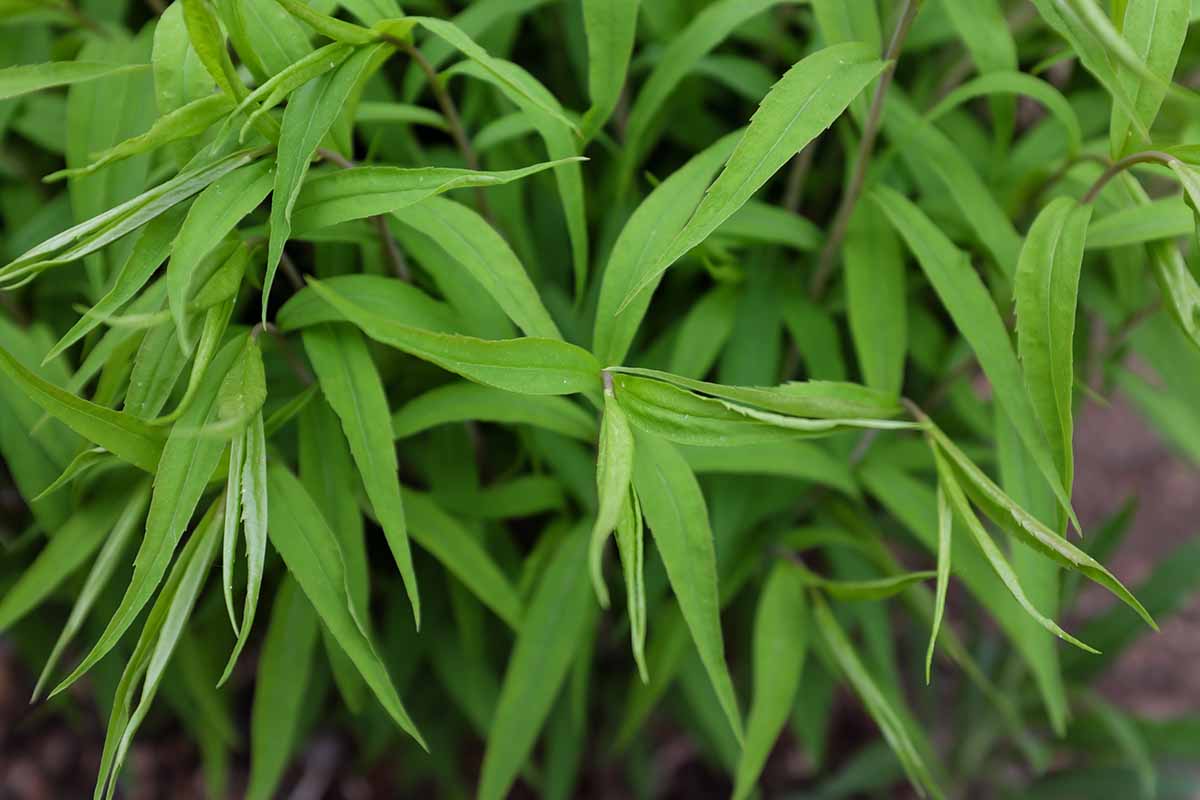
Plants thrive in USDA Hardiness Zones 4 to 9, and reach one to three feet tall with a three-foot spread.
With a clumping growth habit, S. caesia is much better behaved in garden settings than some other solidagos, and is not an aggressive spreader, making it an ideal choice for a compact garden.
S. caesia grows well in full sun, part shade, or full shade. Soil should have good drainage, can be moist to occasionally dry, and should be slightly acidic to neutral in pH.
This species was one of several Solidago species trialed by the Chicago Botanic Garden in 1993, and was found to have excellent resistance to both powdery mildew and rust.
2. Canada
Canada goldenrod is native to most of North America, including Canada, the US, and Mexico.
As a generalist species, S. canadensis grows in a vast number of habitats, including prairies, plains, meadows, and forests. It can grow on dry slopes, and is also found growing in riparian areas, such as alongside streams.
It’s also frequently found along roadsides, in ditches, and in old fields and abandoned pastures.
This species has pyramidal flower clusters that have an arching shape, blooming in fall.
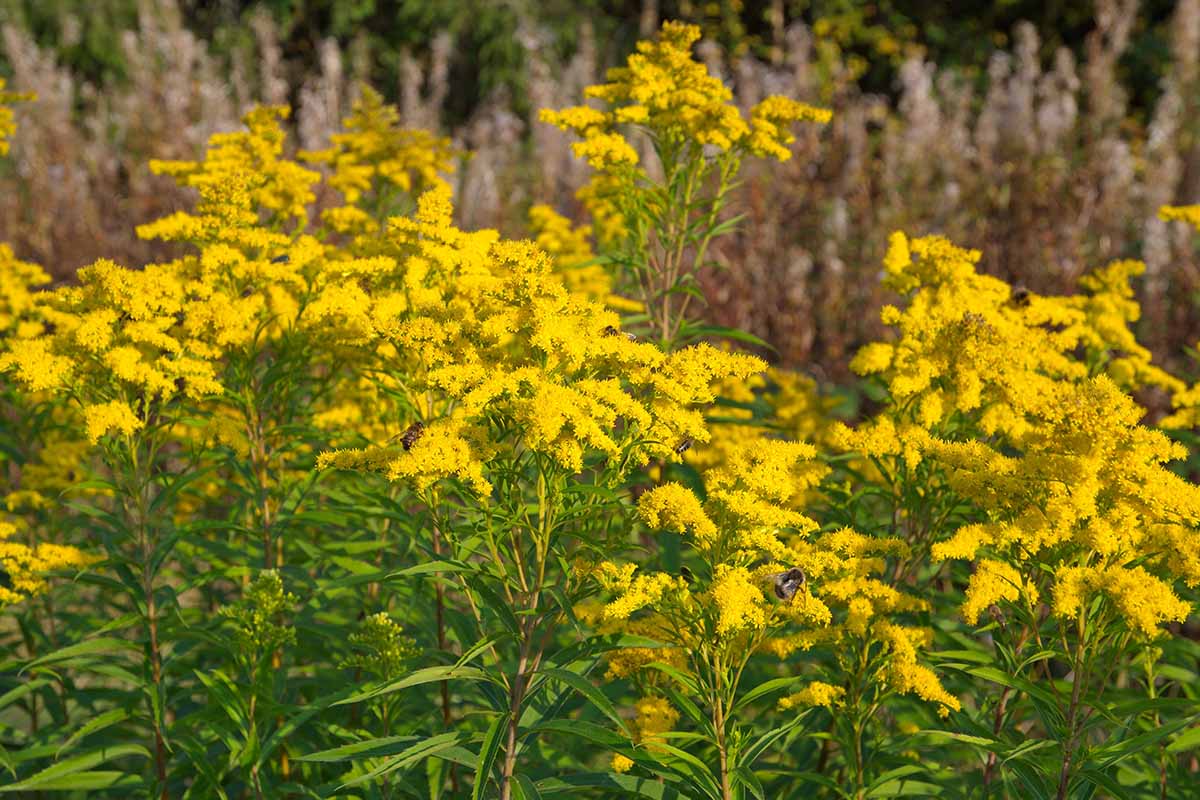
Plants have an upright growth habit, reach two to six feet in height, and sport green to reddish stems that are hairy.
Hairy green leaves are linear or lance-shaped with serrated leaf margins, and have three parallel leaf veins.

S. canadensis spreads aggressively from its rhizomes, making it a great selection for meadows or other landscaping projects where it can naturalize.
This species can be prone to powdery mildew, so where this fungal disease is a concern, it would be prudent to choose a species with better resistance.
Canada goldenrod will thrive in USDA Hardiness Zones 3 through 9, and will grow in full sun or part shade.
This species will thrive in dry to moist conditions, and is adapted to a wide range of soils, including sandy, loamy, clayey, or caliche soil types.

You can find S. canadensis seeds for purchase in an array of package sizes from Everwilde Farms, via Amazon.
3. Gray
Gray goldenrod, classified for scientific purposes as S. nemoralis, is native to Southern Canada and the eastern two thirds of the United States.
Also known as “common goldenrod,” “old field goldenrod” and “prairie goldenrod,” in the wild, this species thrives in dry, open woodlands, in upland prairies, and on sand dunes.
It can also be found growing along roadsides and railroads, and in fallow fields and pastures.
The yellow flowers of this Solidago are one-sided; that’s to say they are situated on only one side of the plant’s floral stems. Blooms measure one-quarter of an inch, growing on arching inflorescences, and blooming from late summer through autumn.
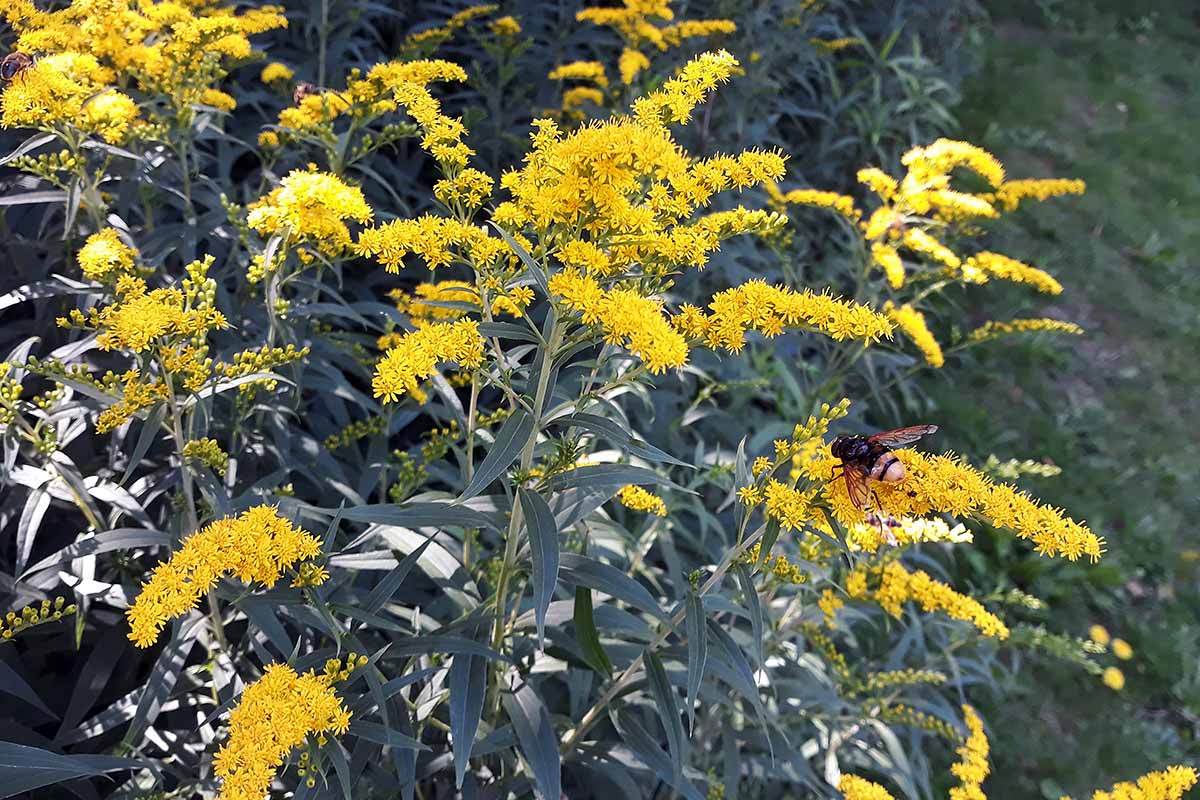
Small-statured plants have an upright growth habit, reaching six inches to two and a half feet tall, and have stems that are covered with gray hairs.
Alternate leaves are grayish or silvery green. They’re covered with fine hairs, and have smooth or slightly serrated margins.
This species has spreading, creeping rhizomes and is good for naturalizing in the landscape, such as in a meadow or cottage garden. While it does spread easily, it is, however, less aggressive than some other Solidago species.
S. nemoralis is hardy in USDA Hardiness Zones 2 to 9 and grows best in full sun or light shade.
Though it prefers slightly acidic soils and requires good drainage, it can thrive in a wide array of soil types, including sand, loam, clay, caliche, or rocky soils.
S. nemoralis prospers with dry to medium soil moisture and is drought tolerant.
With an extremely broad native range and great adaptability, this species is one of the best native wildflowers for the US and Canada.

You can purchase S. nemoralis seeds in a selection of packet sizes from Everwilde Farms via Amazon.
4. Ohio
Ohio goldenrod is native to the Great Lakes region of the US and Canada, growing in wet and moist zones such as along shores, in wet prairies, and even in bogs.
Classified as S. ohioensis, this species bears large, flat-topped clusters of yellow flowers at the ends of its stalks.
Also sometimes classified as Aster ohioensis or Oligoneuron ohioense, Ohio goldenrod blooms from late summer to fall.
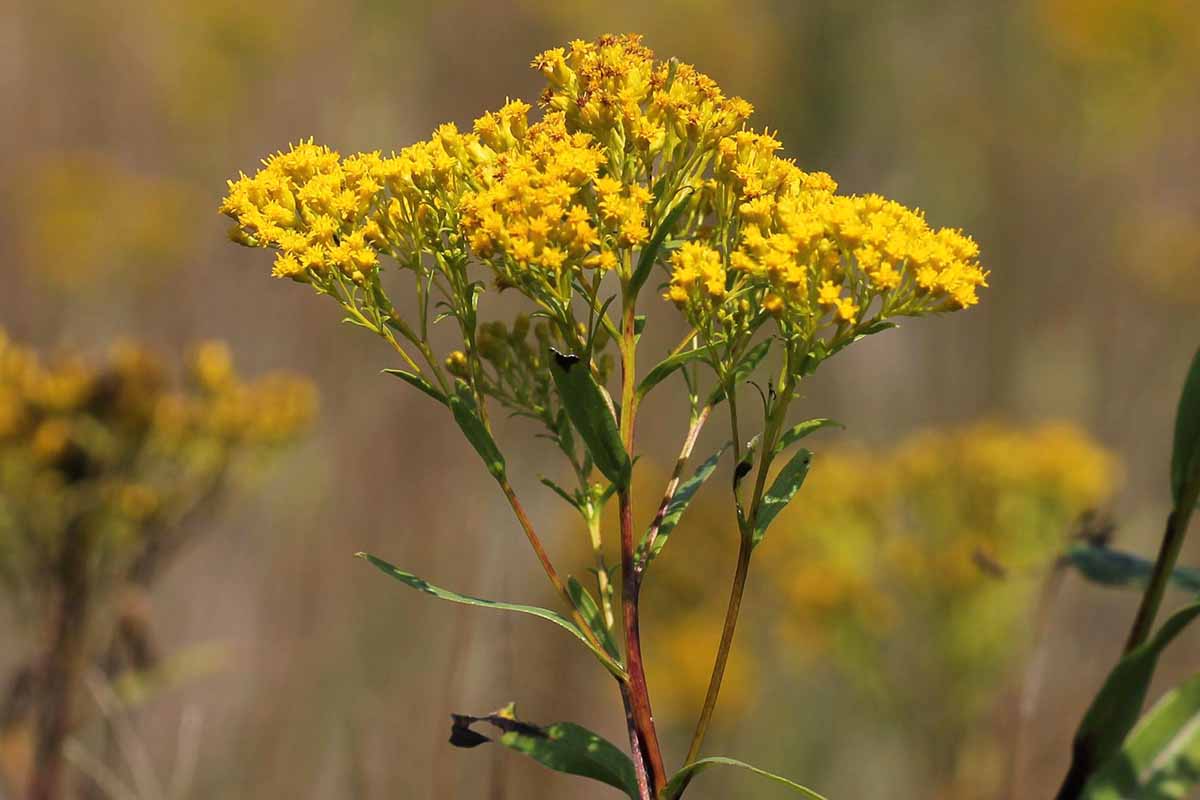
Plants reach two to four feet tall and have an upright growth habit. Leaves are lance shaped and may have red veins. Stems may also be red in color.
S. ohioensis can grow in full sun or part shade, and thrives in slightly acidic to slightly alkaline soils. It will prosper in clay, loam, peat, or sandy soils.
Plants spread via rhizomes, but not aggressively, and have good resistance to powdery mildew.
You can learn more about growing Ohio goldenrod in our article. (coming soon!)

If S. ohioensis sounds like the species for your landscape, you’ll find seeds in an assortment of package sizes from Everwilde Farms via Amazon.
5. Prairie
Prairie goldenrod, also known as “upland white goldenrod” or “sneezewort,” is native to parts of the US and Canada.
In Canada it spreads from Quebec to Saskatchewan, while in the US its native range includes parts of several different regions including New England, the Southeast, the Great Lakes region, the Upper Midwest, the South Central region, and the Northern Rockies and Plains.
S. ptarmicoides grows in dry habitats such as dry, calcareous prairies, or open-canopied woodlands.
And if you thought goldenrods only came in shades of deep yellow, this flat-top goldenrod will be a surprise – its flat clusters of flowers have white petals and pale yellow centers.
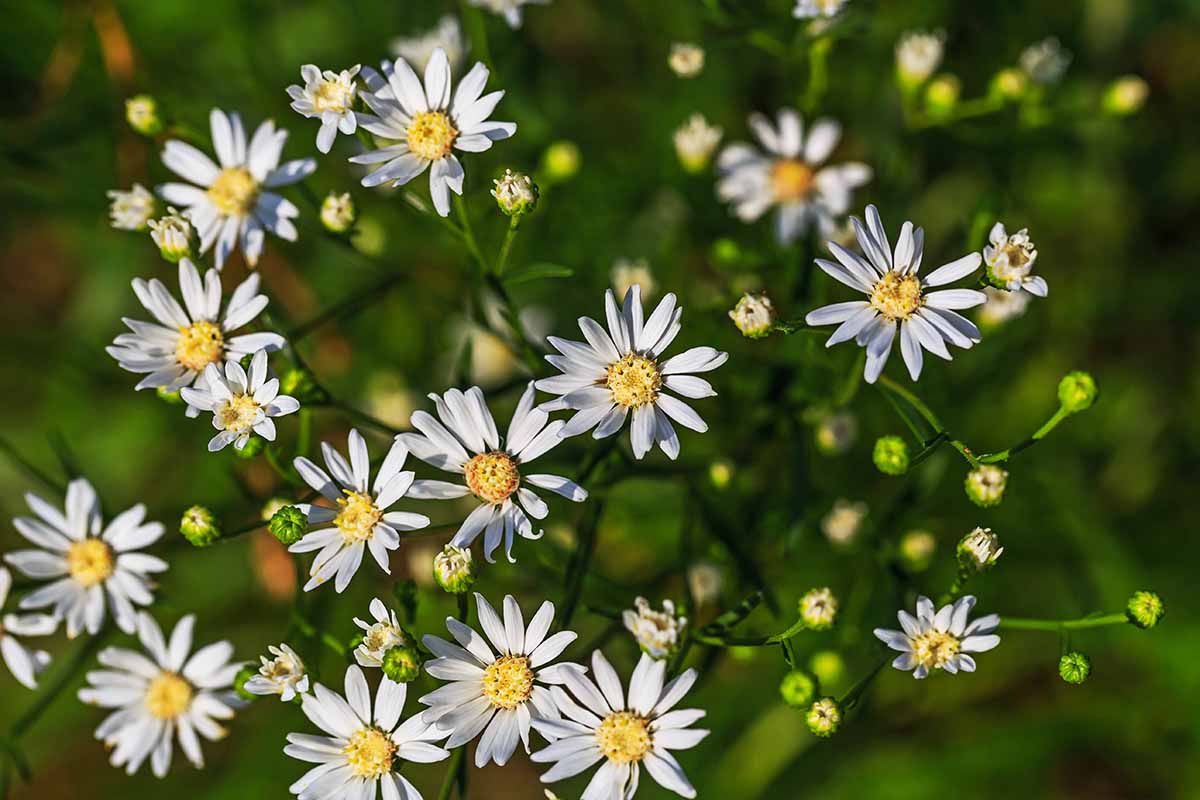
Previously classified as an aster by the scientific name of Aster ptarmicoides and known by the common name “upland white aster,” scientists noticed that this plant hybridizes easily with other Solidago species but not with asters, and decided to reclassify it.
Flat-topped solidagos were also reclassified to a different genus, Oligoneuron. Not everyone in the scientific community has jumped on board with the new nomenclature, but you’ll sometimes find this plant’s scientific name updated to Oligoneuron album.
Returning to more practical matters, these plants reach one to two feet tall, and have a bushy growth habit with linear or lance-shaped leaves.
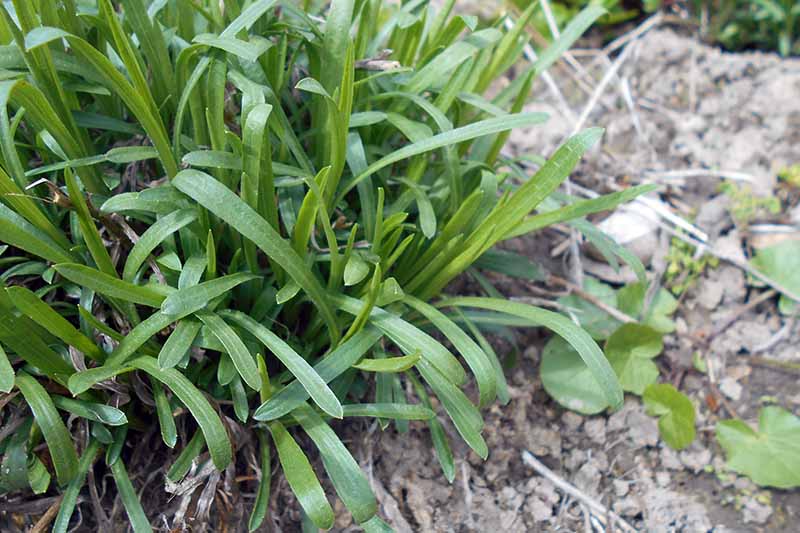
Upland white aster grows best in full sun in dry to medium moisture conditions.
It needs good drainage with a neutral to alkaline pH. This species grows well in sandy, gravelly, and chalky soils but will also tolerate loam.
S. ptarmicoides is hardy in USDA Hardiness Zones 3a to 8a.

You can purchase white upland aster seeds in an array of packet sizes from Everwilde Farms via Amazon.
6. Rocky Mountain
Rocky Mountain goldenrod is a low-growing species that is native to Canada and the Western and Central US.
Also known as “northern goldenrod” and “alpine goldenrod,” in the wild, S. multiradiata can grow at lofty elevations that reach up to 12,500 feet.
Its natural habitats include mountain meadows, tundra, open forests, and subalpine areas.
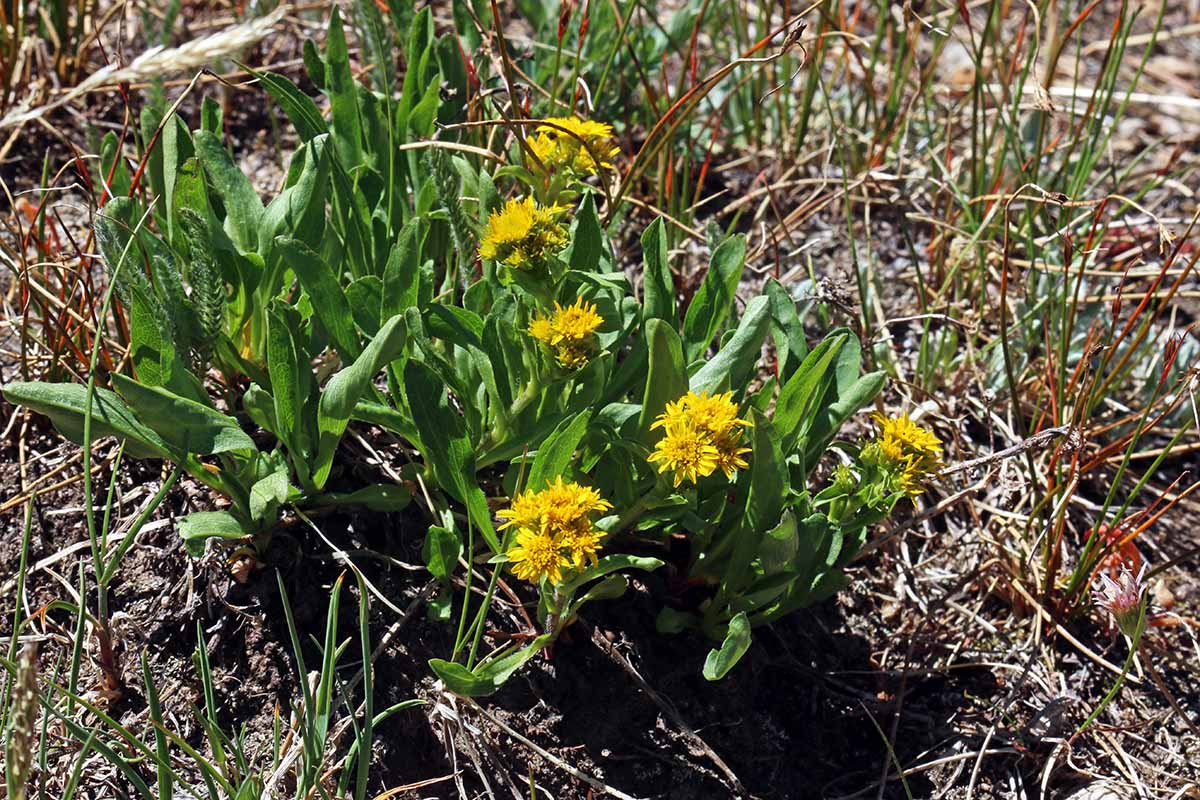
S. multiradiata bears upright, rounded clusters of golden flowers that bloom from late summer through fall.
Leaves are medium green and mostly basal, broad, and smooth, forming a ground cover. One of the smaller Solidago species, S. multiradiata reaches only six to 12 inches tall.
Plants spread via rhizomes, but this species is not an aggressive spreader and will work nicely in smaller spaces.
S. multiradiata is adapted to part shade and dry conditions. It grows best in alkaline rocky or sandy soils and is hardy in USDA Zones 4 to 9.
7. Rough
Rough goldenrod is native to the Eastern two-thirds of the US and Canada.
Its natural habitats include wetland areas such as marshes, swamps, and coastal plains, as well as grasslands, forest edges, and sand dunes. It can also be found in disturbed areas such as fields, trails, and other clearings.
S. rugosa produces its yellow blooms in arching panicles, which bloom from early to late autumn.
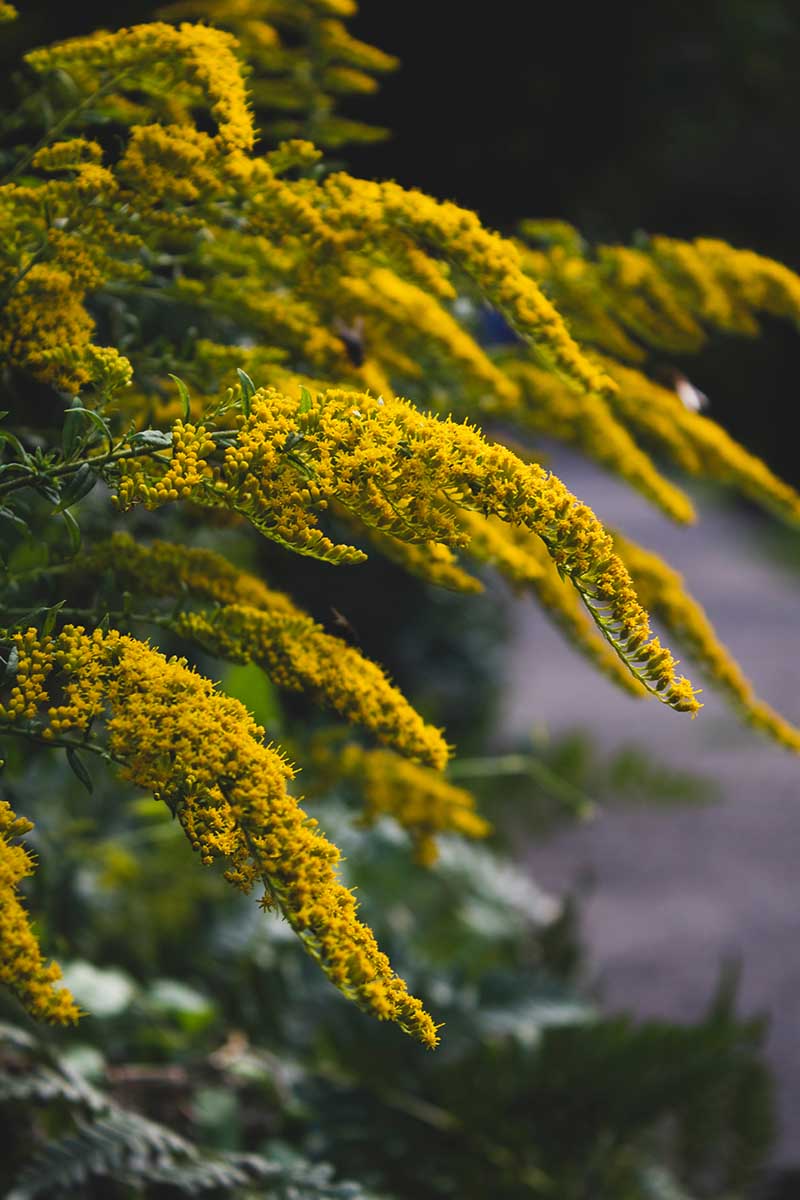
Also classified as Oligoneuron rigidum var. rigidum, plants generally reach two to six and a half feet tall, but sometimes grow up to eight feet tall.
The stems of S. rugosa are usually hairy, and its alternate leaves are lance-shaped, oval, or elliptical with serrated margins.
Leaves have prominent veins, creating a rough or wrinkled texture, and inspiring another common name, “wrinkled goldenrod.”
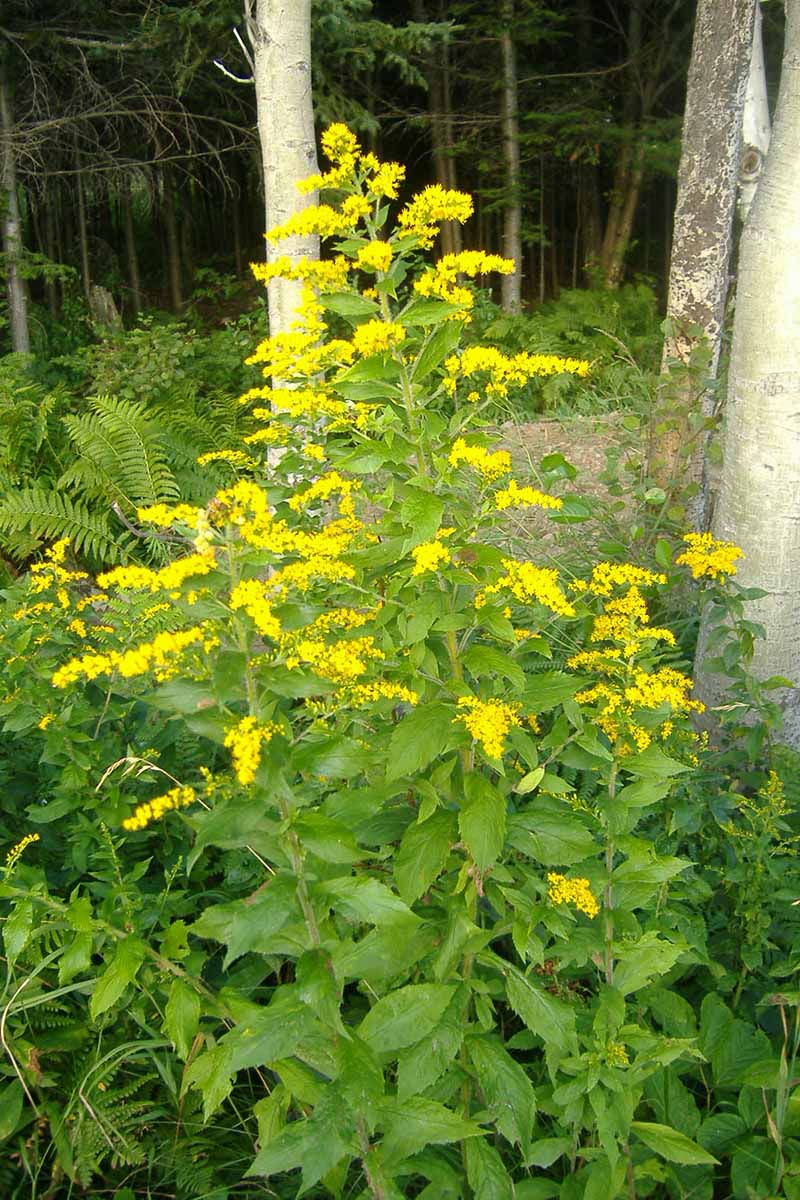
This species grows from creeping rhizomes and is an aggressive spreader, making it best used in situations where it can naturalize, such as meadows or natural areas.
S. rugosa does best in full sun but tolerates light shade.
It will grow in well-drained wet and moist areas, in slightly acidic sandy or loamy soils, and is hardy in USDA Hardiness Zones 3 to 9.
Learn more about growing rough goldenrod in our article. (coming soon!)

You can find S. rugosa seeds for purchase from Roundstone Native Seeds via Amazon.
8. Showy
Showy goldenrod is native to the Eastern and North Central United States where it grows wild in prairies, clearings, and along woodland edges. It is also frequently found in old fields.
Classified as S. speciosa, this wildflower takes its species name, speciosa (as well as its common name, “showy”) from its impressive sprays densely covered in flowers.

The plume-like inflorescences of this species are upright, pyramidal panicles, reaching up to one foot long on two- to six-foot plants and blooming from summer through autumn.
Plants are upright with reddish or green stems.
Leaves have smooth margins, and their surfaces are usually smooth, not hairy. Basal foliage is large, oval shaped, and feels somewhat fleshy.
S. speciosa spreads via rhizomes, though not very aggressively.
This drought-tolerant species grows best in full sun to light shade, in well-drained dry to moist soils.
S. speciosa prefers sandy or loamy soils but tolerates rocky and clay soils as well, and is hardy in Zones 3 to 9.

You’ll find S. speciosa seeds in a selection of package sizes from Everwilde Farms via Amazon.
Or if you’d rather start with live S. speciosa plants, head to Nature Hills Nursery.
9. Stiff
Stiff goldenrod has a broad native range. In Canada it stretches from Ontario to Alberta, and in the US from Massachusetts to Georgia, reaching west to Texas, New Mexico, Colorado, Wyoming, and Montana.
This flat-topped species, classified by some as S. rigida, is adapted to dry habitats, such as dry prairies and woods.
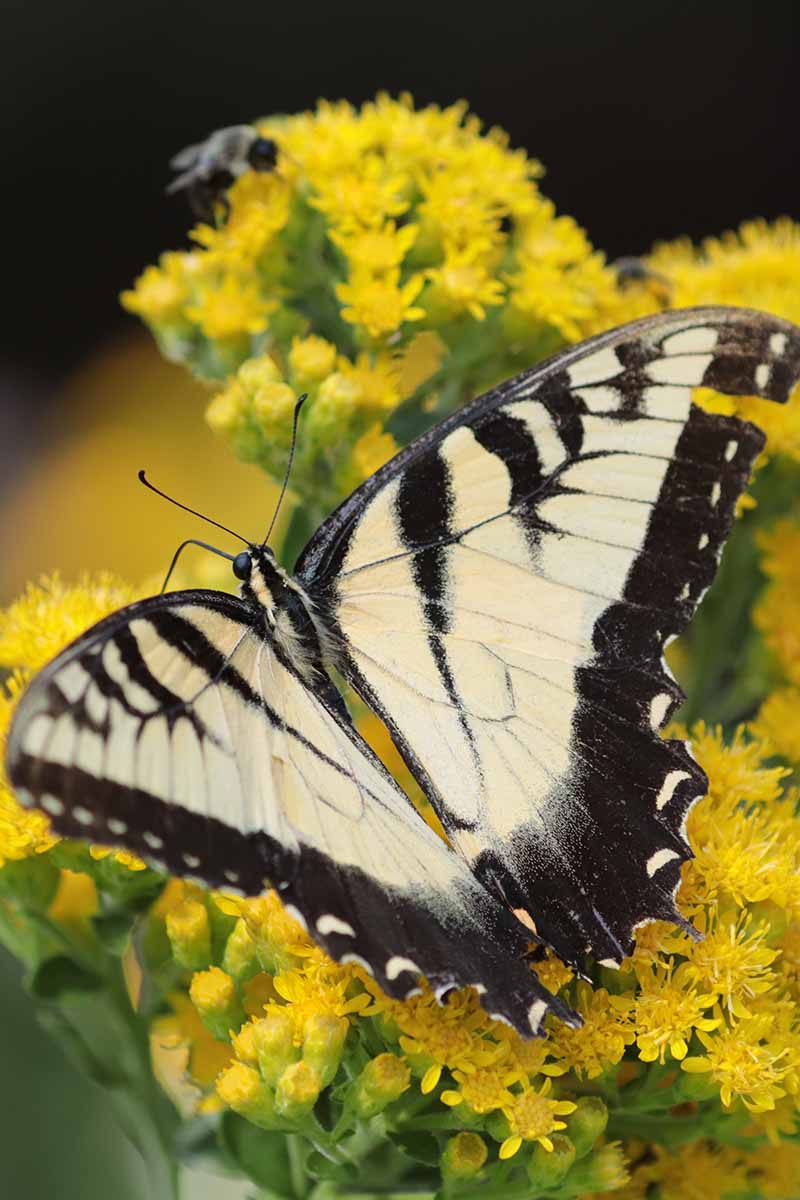
Classified by others as Oligoneuron rigidum var. rigidum, this species has flattish or slightly domed inflorescences that bear yellow or gold blooms. Flowers measure one-third of an inch across and bloom from late summer to early or mid-autumn.
S. rigida has an upright growth habit with alternate, toothed leaves that are stiff and leathery.
Also known as “rigid goldenrod,” “hard leaf flat-top goldenrod,” and “hard-leaved goldenrod,” the leaves and stem of this species are usually hairy, and the foliage is grayish-green in color.

Plants grow from one to five feet tall and don’t spread wildly via their roots, which have a clumping form. But this species is nonetheless somewhat of an aggressive spreader through self-seeding. Spent flower heads can be pruned to prevent this.
S. rigida grows best in full sun with dry to moderate moisture in clayey, sandy, or loamy soils.
Showing good resistance to powdery mildew, this species is hardy in Zones 4 to 9.
Learn more about growing stiff goldenrod in our article. (coming soon!)

If this species sounds perfect for your purposes, you’ll find S. rigida seeds available for purchase in a choice of packet sizes from Everwilde Farms via Amazon.
You can also find S. rigida for purchase as live plants from Nature Hills Nursery.
A Solid Gold Selection
After learning about these different goldenrod species, you should now be able to select one of the nine that is well-suited to your growing conditions and that will fit into your landscape.
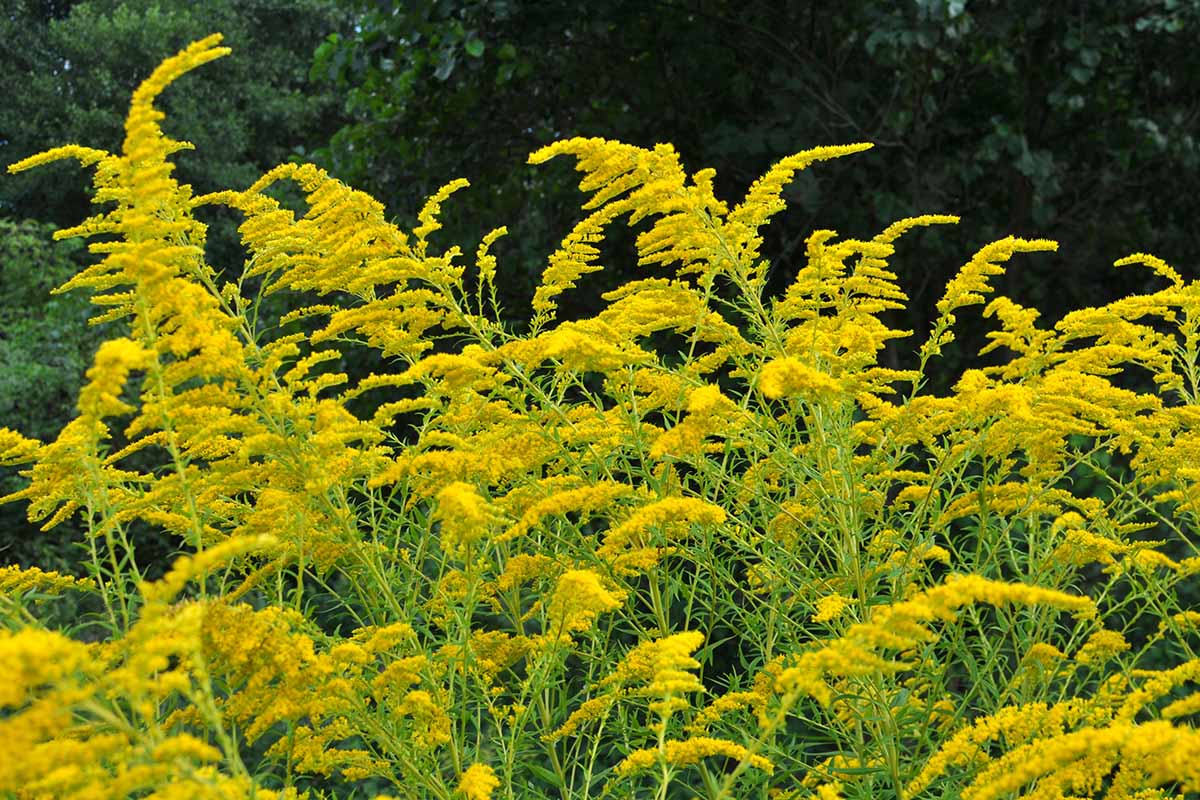
Which Solidago are you going to welcome home? Do you have any other favorites that we didn’t include on our list? Let us know in the comments section below.
And if you still have wildflowers on your mind, why not check out these articles next?
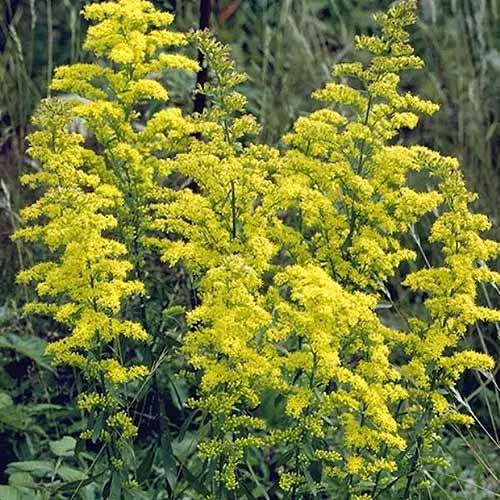
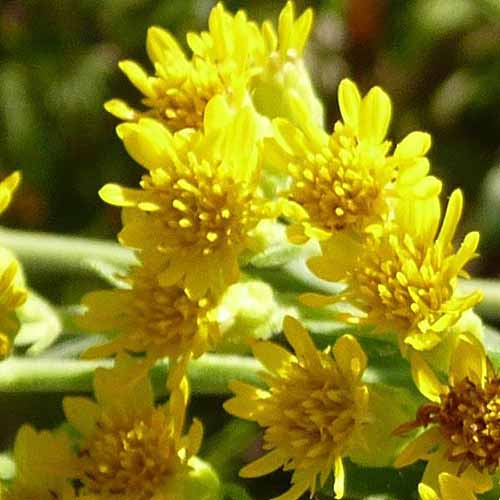
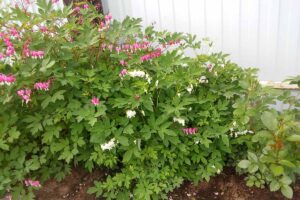
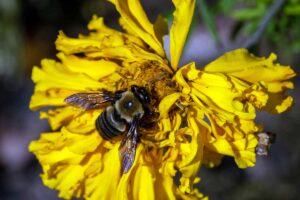
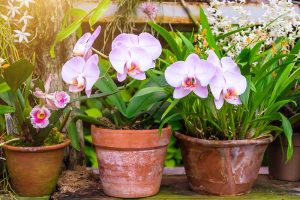
Thanks for the great info! I have a lot of S. caesia in my shady garden and love it. The pic of it in the article is definitely another kind.
Hi Steph,
Glad you enjoyed the article. And thanks so much for your feedback on the photo – I do believe you are correct. We are going to remedy that asap!
Thanks!
I really appreciated the article on the value of planting these underappreciated and often maligned garden essentials. I’d like to nominate Solidago flexicaulis (Zigzag Goldenrod) as #10, as it and S. caesia make a lovely combination in a shade garden at a time when most woodland plants are long past flowering and add a bright accent to the increasing darkness of fall.
Hi Dave,
Thanks for your comment and for sharing your experience with these wonderful plants. Great nomination for number 10. (And we’ll certainly consider adding it the next time the article gets updated.) In case any of our readers are wondering, zigzag goldenrod (S. flexicaulis) is native to the eastern and central regions of the US and Canada. It can be grown in USDA Hardiness Zones 3-8, and as Dave mentioned, can be grown in shade or part shade. Thanks again Dave for your shout out for zigzag goldenrod!